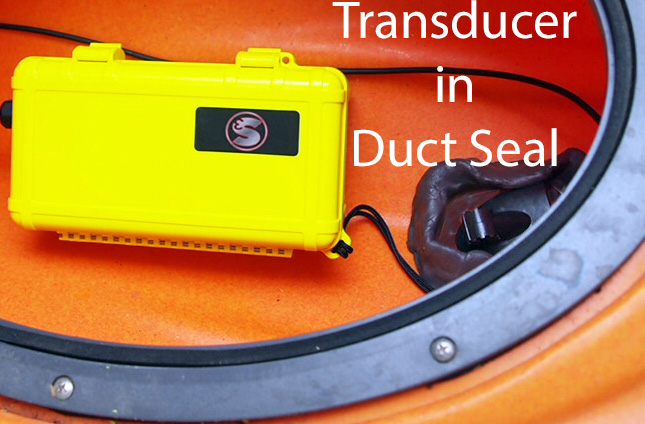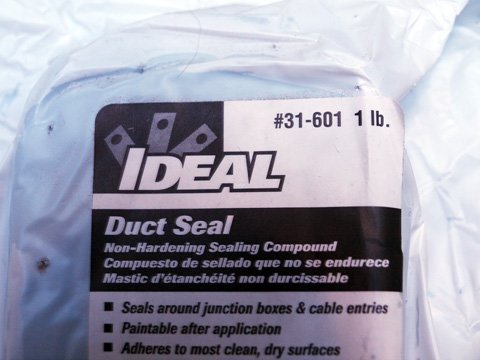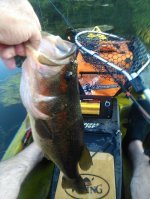~~ Duct Seal Putty ~~
The Perfect Solution
for Securing Your Transducer
Who knew that a product called Duct Seal, a type of electrical putty, would become the perfect solution for securing your transducer inside your kayak. It has been a "Set It and Forget It" kayak transducer solution that has worked flawlessly every single time I've been on the water. Thousands of kayak fishermen have discovered this great product and so can you.
Using the putty method of installing your transducer allows you to "shoot through the hull". This means the transducer is inside your kayak and the transducer never touches the water, yet works perfectly as it should.
The Photo above shows a Humminbird Transducer in putty. The yellow box is the kayak power supply system for the fish finder designed and assembled by Hammerhead Kayak Supply. You can find these on the website. All photos by Russ James. Do not use without permission.
What is Duct Seal Putty?
I get a lot of questions asking the best way to mount the transducer. Using this putty is the best I have found. Here are just a few of the characteristics.
- Duct Seal is an Electrical Putty
- It can stay soft, pliable and workable for years
- It is completely water resistant
- Withstands heat to over 500 degrees
- Withstands extreme cold
- Is slightly sticky and will stick firmly to most materials
- Will not harm polyethylene, the material most kayaks are made of
- Transducer sticks firmly in the putty and will not fall out even when upside down
- Transducer is inside the kayak (see top photo) and always safe against damage
How to Use Duct Seal
Here is a step by step description of using putty to mount your transducer inside your kayak.
- Make sure you know exactly where your fish finder will be mounted and where the wires will be. In most sit on top fishing kayaks, the fish finder will mount up front in front of the top hatch. Make sure all your fish finder cables are hooked up correctly.
- Determine where you want the transducer to be mounted. The transducer should be shooting straight down so even if your kayak has a slight "V" bottom that is ok. It can still be mounted right in the "V" using this method so the sonar is shooting down and not at an angle.
- Get a 1/2 pound sized piece of putty and form "hamburger patty" an inch or so wider than the transducer. If you have a "V" shaped bottom you can make it a bit thicker.
- Make sure you work the patty to ensure there are no air bubbles. Squeeze and kneed it as much as needed if you see any bubbles. The Duct Seal doesn't come with any bubbles and is shrink wrapped at the factory. Taken straight from the package you will probably not get any bubbles at all if you are careful.
- Important: This method using putty works because there is absolutely no air between the transducer and the kayak hull. If air bubbles are in the putty it will hinder the transducer and your fish finder will not work or you will get poor results at best.
- Put the putty where you want the transducer to go. Press firmly to ensure every square inch is against the kayak hull. It should be flat on top where the transducer is to be placed.
- Press the transducer into the putty firmly. You can curl the edges of the putty to add a little protection to the transducer if you like.
- There is no need to add water inside the trough made when you curled the edges around the transducer. Years ago I actually tried the water method first and it didn't work at all. I then tried the above method and it has worked flawlessly.
- You're all done!
Problems with Other Methods of Mounting the Transducer
There
are a number of ways kayakers have mounted fish finder transducers.
Some work well but come with their own set of problems. I am sure that some people have figured out ways around the problems and are using one of these methods just fine. But this will give you an idea of what is out there and any potential problems that exist.
Gluing the transducer directly to the kayak using marine glue.
This may be a popular method. You simply put marine glue on the kayak hull where you want the transducer to go. You still need to make sure there are no air bubbles which is hard to do when working with a tube of glue.
You will then have to tape the transducer down firmly until the glue hardens. Pray the tape doesn't fail before it has time to set. You won't know if it works until it is dry. If you have bubbles it can be some work to get the glue off and try again.
Over the Side of the Kayak Transducer Mount.
This works well. The transducer is mounted on PVC and can be mounted so the transducer is in the water off the side of the kayak.
The problem is that you have a lot of drag on that side of the kayak. You will have a lot of corrections strokes and the drag will slow you down. It can get in the way when fishing on weedy or brushy lakes.
Through the Scupper Hole Transducer Mount
This is another popular way of mounting a transducer. The transducer is mounted on a length of PVC plastic pipe the size of the scupper hole. The transducer is placed in the kayak from the bottom. If you make your own it can be a bit time consuming to get it right. There is slight drag and on rivers there is dangers of hitting rocks.
Because the PVC pipe is inserted from the bottom, if you want to remove it you have to get out and turn the kayak over. You cannot drag your kayak over anything while the transducer is in place.
The PVC pipe may be in the way if it is near the feet, but can be mounted in any scupper hole.
Duct Seal to Hammerehad Kayak Supply Home
Copyright 2015-2025 Hammerhead Kayak Supply's Legal Information Our Privacy Policy and Terms of Use |



